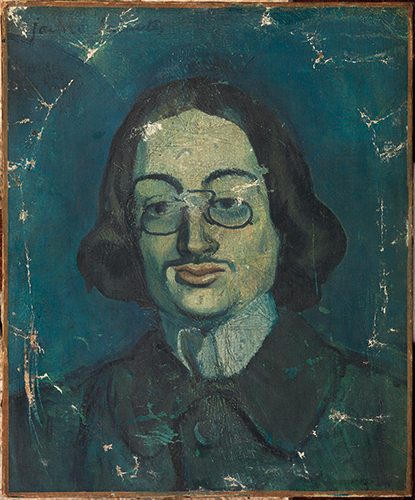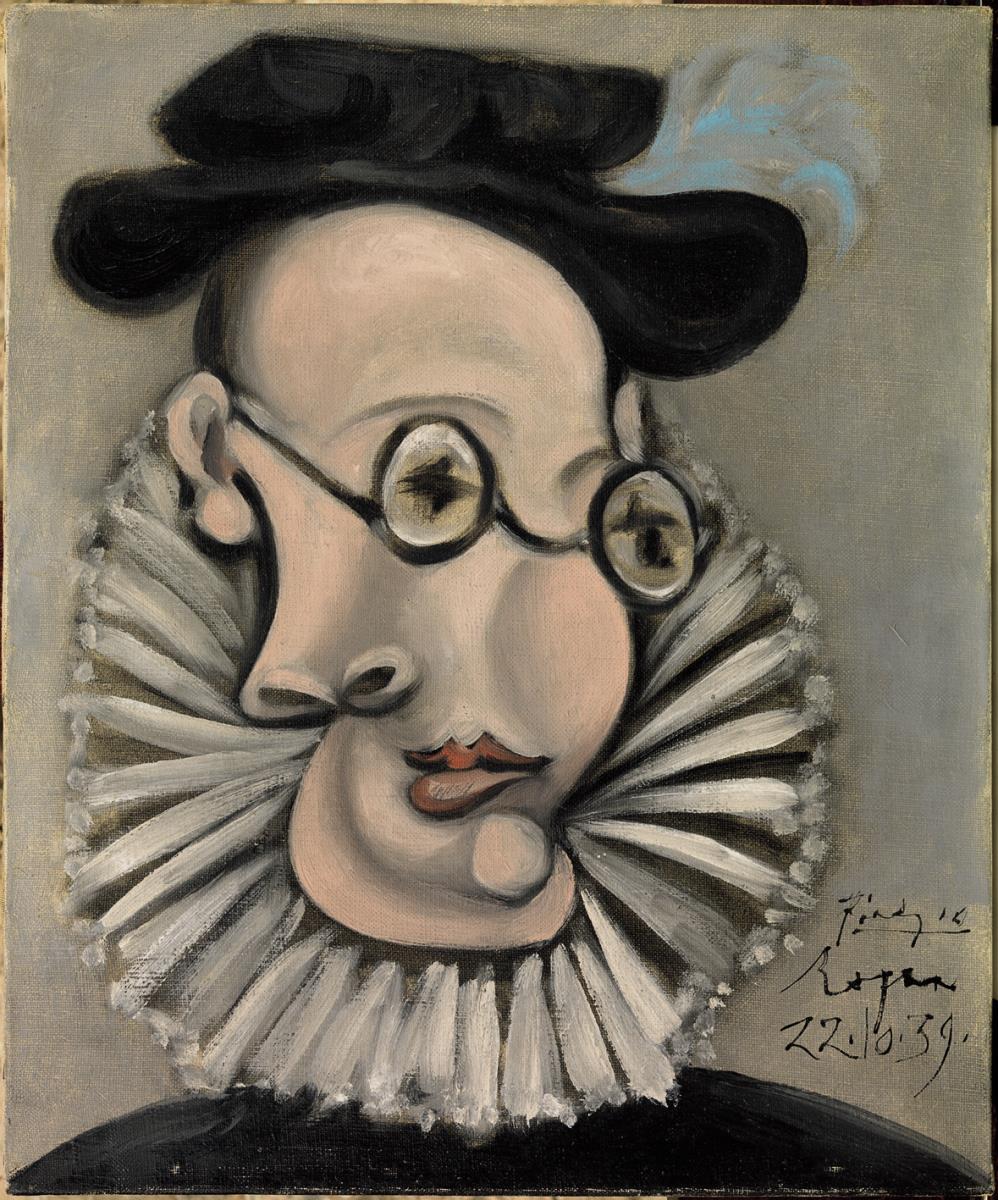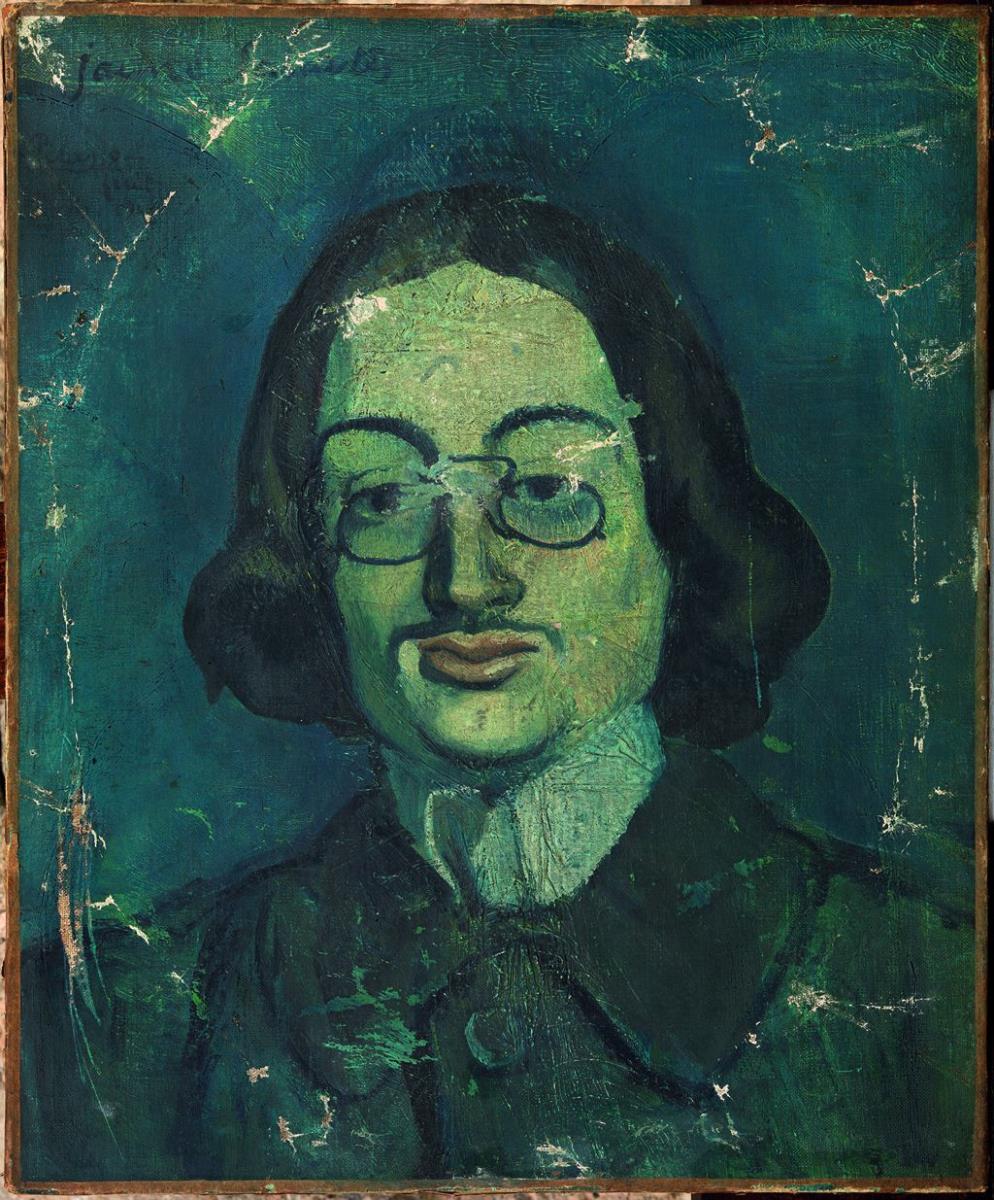Jaume Sabartés i Gual was born in Barcelona on June 10th 1881 in the street of Sant Pere més Baix, nº 84. He was the son of Francisco Sabartés Obach, a primary school teacher, from Oliana, and Marial Gual Oromí, from Barcelona. Sabartés is known for having been the personal secretary and confidante of Picasso and also his main biographer.


Pablo Picasso. Portrait of Jaume Sabartés with ruff and cap . 22/10/1939. Oil on canvas . 46 x 38 cm. Gift of Jaume Sabartés 1952. MPB 70.241. Museu Picasso, Barcelona / Gasull | Portrait of Sabartés s/d. Fons Jaume Sabartés. Museu Picasso, Barcelon
Sabartés was formed in the art school of La Llotja in the ambience of artistic and literary modernism. Initially his artistic activity was directed towards sculpture and poetry, signing under the pseudonym Jacobus Sabartés. Within the cultural framework of the time, he exhibited in the Sala Parés gallery in 1901, he recited poems in the bar Quatre Gats and he also collaborated in the magazine Joventut.
He was a friend of Mateu Fernández de Soto who introduced him to Picasso in 1899 when both of them were just 18 years old. De Soto took Sabartés to the studio in which Picasso was working at that time and that he was sharing with Josep Cardona, in the street of Escudellers Blancs nº 1 of Barcelona, close to the square of Plaça Reial. Based on that first meeting, they forged a very close friendship, and from that moment on Sabartés would become a firm defender of the work of Picasso right until the end.
"Of my first visit to the studio in the street of Escudellers Blancs I still conserve the memory of the farewell. It was midday. My eyes were still impregnated with what I had seen on his papers and in his note books... Picasso, standing in the corner of the angle formed by the corridor that passed in front of the fourth studio, he rummaged into my confusion with that fixed gaze of his. On passing in front of him to say goodbye I insinuated a sort of reverence, surprised by the magic force revealed to me: the marvelous power of the Magi who offer presents which are so rich in surprises and hopes."[Picasso, an intimate portrait]
Pablo Picasso. “Decadent poet”. Portrait of Jaume Sabartés. 1900. Charcoal and watercolor paper . 48 x 32 cm. MPB 70.232. Museu Picasso, Barcelona / Gasull
Nevertheless, his friendship with the genius was split in two very different periods: the first, during the period of their youth, until Sabartés left for the Americas in 1904, and the second, from 1935 onwards, when Picasso called him once again to be by his side, in full maturity of both of them.
During the period of their youth, Sabartés and Picasso lived the Bohemian life of Paris and Barcelona, especially in the area that would today be Ciutat Vella. In this first period of friendship, Picasso did five portraits of him. The very first of them, shortly after they first met, was “Decadent Poet” (1900), a work that can currently be seen in Gallery 4 of the museum.
In 1901 Sabartés travelled to Paris following in the footsteps of Picasso, who during his stay would paint the Blue portrait of Jaume Sabartés. This portrait, which can also be seen in Gallery 8, devoted to the Blue Period, should have been delivered by Picasso to the family home of Sabartés on returning to Barcelona (given that Sabartés prolonged his stay in the city). However, on the way to the Sabartés family home, Picasso stopped at the tavern of Quatre Gats and ended up hanging the painting there. Some years later, once the tavern had closed, Picasso recovered it.
Pablo Picasso. Blue portrait of Jaume Sabartés. 1901. Oil on canvas. 46 x 38 cm. MPB 70.491. Museu Picasso, Barcelona / Gasull
Three years later in 1904, Sabartés decided to cross the Atlantic and go to Guatemala. On the way, he spent a couple of weeks in New York, and subsequently embarked on the steamship Newport in Panama, which took him as far as Guatemala on July 21st, where he met up with an uncle on his mother's side, Francisco Gual Oromí. For the next 23 years the two friends were separated, even though there is evidence that they kept in touch by means of correspondence in a more or less periodical way.
During the American period Sabartés joined the South American artistic and cultural world and made a place for himself in the intellectual circles of the time by working as a journalist, teacher, writer, and occasionally as an art critic.
On January 11th 1908, when Sabartés was then 26 years old, he married Rosa Robles Corzo, with whom he had a baby boy seven years later, Mario de Jesús Sabartés Robles. The Sabartés Robles family moved between New York and Guatemala until 1927, when the whole family crossed the Atlantic and settled down in Barcelona. By then, Sabartés was 46 years old. However, a short time later, the couple split up.
Picasso and Sabartés s/d Fons Jaume Sabartés. Museu Picasso, Barcelona. Photo: Jacqueline Picasso
Subsequently Sabartés met up once again with Mercedes Iglesias, his girlfriend from his youth, with whom he had never stopped corresponding and they decided to move to Montevideo where he worked for the newspaper El Día. It was there in 1935 that he received a letter from Picasso asking him to come back, to be by his side. Sabartés definitively crossed the Atlantic and then moved into the house of Picasso in the street of Boétie in Paris. As he tells it:
“From that day on, my life remained in the wake of his, without ever wondering how long this excitement would last, that we proposed would be forever.” [Picasso, an intimate portrait]
During this second period of friendship, Sabartés would become the personal secretary of Picasso until his death and also his main biographer; he wrote the works Picasso en su obra (1936) and Picasso, an intimate portrait (1946). Between each of them he published two novels, Don Julian (1942) and Son Excellence (1945) related to his stay in Guatemala.
Throughout this period, Picasso also did various portraits of him, especially caricatures. Among these is the well-known oil painting Portrait of Jaume Sabartés with ruff and cap, that can be seen in Gallery B1.
Pablo Picasso. Humorous composition. Portrait of Jaume Sabartés and the pin-up Sylvia López. 24th March, 1958. Brush and Indian ink on magazine printed paper. 51,3 x 35 cm. Gift of Jaume Sabartés. MPB 70.669. Museu Picasso, Barcelona / Gasull
A few months after the publication of Picasso, portraits et souvenirs, in November of that same year, Picasso painted what would be the last portrait of Jaume Sabartés specifically on the title page of a copy of the book.
It is also during this second stage that Sabartés made a donation of the collection that he had related to Picasso. Specifically, in 1953 he donatedto the Museo de Bellas Artes of Malaga his Picassian bibliographic collection of some 400 titles, and then in 1960, by indication of Picasso himself, he donated the works that he had from the artist to the City Council of Barcelona so as to inaugurate the Museu Picasso on March 9th 1963. Furthermore, apart from the works agreed initially, Sabartés started increasing the patrimony of the museum with the periodical delivery of the prints that Picasso had been sending and dedicating to him.
Jaume Sabartés. Picasso, portraits et souvenirs. Louis Carré et Maximilien Vox, 1946. In-12, br., couverture illustrée, 238 pp. Enrichi d'un portrait de Jaime Sabartés au crayon et au pastel, daté et signé " 24.11.63 ", envoi à Jean L. Joint : même ouvrage, avec autre portrait de Jaime Sabartés au crayon et au pastel, daté et signé " 24.11.63 ", envoi à Marie-Paule L. Font www.artcurial.com
Jaume Sabartés died on February 13th 1968 in Paris. In his honour, Picasso donated the series of Las Meninas to the Museu Picasso and also sent copies of each of his recent prints to the museum with a posthumous dedication to his very close friend: “Pour Sabartés”.
All in all, Sabartés, always in the shadow of Picasso, wasn't only his friend and confidante, but also to a great extent the constructor of his image as an artist through his writings. As Margarida Casacuberta says in an article in the magazine L’Avenç:
“Sabartés was, more than anything else, a writer, and a writer who reflected about the artistic and literary facts and was perfectly aware of the power of literature in the construction of the reality.” [Sabartés by Picasso. Margarida Casacuberta. L’Avenç]
Bibliography and references
“Jaume Sabartés” a: Josep Palau i Fabre, Picasso i els seus amics catalans. Aedos. Barcelona, 1971. Pages. 107 – 108
“Jaume Sabartés” a: Vallès i Pallarès, Eduard; Gaston Membrado, Elias; Gual Pascual, Malén; Serra Villalba, Pepe. Picasso. Amics catalans de joventut. Centre Picasso d’Horta i Museu Picasso de Barcelona. Barcelona, 2009. Pages. 66-69
“Jaume Sabartés. Retrats i records” a: Margarida Casacuberta. L’Avenç. Num. 338. Barcelona, març de 2013. Pages. 44-51
“Jaime Sabartés en Guatemala: 1904-27” a: Luís Luján Muñoz. Dirección General de Cultura y Bellas Artes. Guatemala, 1981.
“Jaume Sabartés” a: Coord. Malén Gual and Eduard Vallès. Guide to the Collection. Museu Picasso, 2015. Pages. 68-69, 110-117
“Jaume Sabartés, l’ombra del geni” a: Claustre Rafart Planas. Avui. Barcelona, 5th May 1998
“Picasso i Sabartés” a: Claustre Rafart Planas. Girona, 8th February 2008.
"Picasso, an intimate portrait". Jaume Sabartés. Prentice Hall. New Jersey, 1948
"Picasso en su obra". Jaume Sabartés. Cruz y Raya. Madrid, 1936
Catalogue of the exhibition “50 years of the Museu Picasso in Barcelona. The Origins”
Catalogue of the exhibition “50 years of the Museu Picasso in Barcelona. The Collection”







!["Poeta decadente" [Jaume Sabartés]](https://colleccions.eicub.net/api/1/images/https%3A%2F%2Fdobubt4dam3m5.cloudfront.net%2Fpublic%2FHeritageObject%2FH289212%2F142057%2Ffull%2Foriginal%2F0%2Fdefault.jpg)







